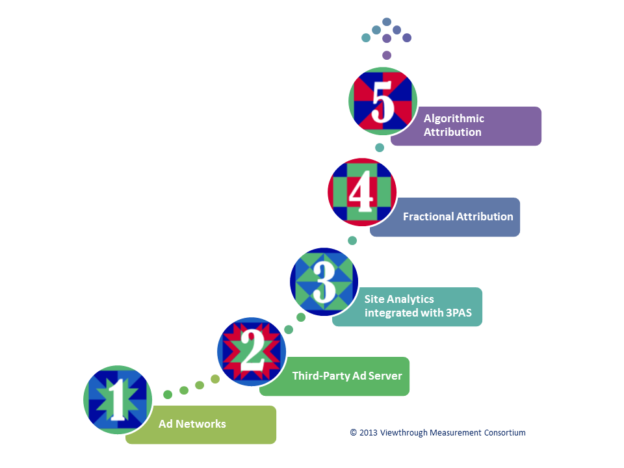In the last post, Buying a Viewthrough Stairway to Attribution – Part 1, we looked at the first two steps in viewthrough measurement. These two are easy enough and come from an ad network partner or your agency’s display ad server.
Proceed to Step #3 brings together the two very different worlds of display ad servers and site-side analytics systems. At a high-level, these systems notoriously have measurement discrepancies – ad servers are typically server-side while modern site analytics solutions are all or in-part JavaScript based. In addition, there are different filters being used to exclude internal and robotic traffic.
Nonetheless, an integrated solution can be a game-changer for most digital advertising clients. Most are still struggling to understand the latent (non-click) but now quantifiable brand influence of display media on subsequent destination site behavior.
- Site Analytics integrated with Third-Party Ad Servers (3PAS)
- Upside: A really powerful way to advance viewthrough measurement capabilities is to leverage the data contained in the digital media agency’s ad server. From that standpoint, the digital marketer is combining the best of both worlds: a) digital media agency-of-record’s ad server platform and b) existing in-house site analytics system-of-record. There are two distinct approaches, either taking the analytics platform and bringing it up the funnel into the ad delivery through ad tagging or make the site analytics platform talk to the ad server via integration. IBM Coremetrics takes the former approach and Omniture Genesis takes the latter. This approach is potentially very powerful because it considers all digital channels, both paid and unpaid in one place. For this reason, attribution can be considerate of all the digital channels being employed. Site analytics technologies that have provided related information to the VMC are included in the Viewthrough Capabilities Scorecard. If yours is not included get in touch.
- Downside: Like ad networks/media vendors, ad servers can only measure what they themselves have tracked via the ads that have been delivered and their advertiser site-side tracking tags (DFA Floodlights and Atlas Universal Tags). While this avoids the single media vendor problem (now all display media being measured in one platform), its efficacy is then limited to tag proliferation on the destination site; this usually means only high-value tasks and conversions get tracked. Using a TMS (tag management platform) such as BrightTag can make this part much easier opening up deep-linked visitation and broader engagement activity. Difficulty on this approach can be high as either the integration must be configured upfront (Adobe Genesis) or there could be ongoing ad ops implications (CoreMetrics). Be careful what you wish for here as as the multiple fractional attribution methods enabled such as last-click, last-touch,now operational beget questions that have organizational/political implications. Like Steps 1 and 2, most of the technologies in Step 3 do not yet have ad-viewability solutions integrated at this time.
- Upside: A really powerful way to advance viewthrough measurement capabilities is to leverage the data contained in the digital media agency’s ad server. From that standpoint, the digital marketer is combining the best of both worlds: a) digital media agency-of-record’s ad server platform and b) existing in-house site analytics system-of-record. There are two distinct approaches, either taking the analytics platform and bringing it up the funnel into the ad delivery through ad tagging or make the site analytics platform talk to the ad server via integration. IBM Coremetrics takes the former approach and Omniture Genesis takes the latter. This approach is potentially very powerful because it considers all digital channels, both paid and unpaid in one place. For this reason, attribution can be considerate of all the digital channels being employed. Site analytics technologies that have provided related information to the VMC are included in the Viewthrough Capabilities Scorecard. If yours is not included get in touch.
In Buying a Viewthrough Stairway to Attribution – Part 3, we’ll address the above point about fractional attribution. We’ll look at taking this question away altogether from human marketers and allowing the data to speak for itself through heavy datamining and algorithmic attribution modeling.





